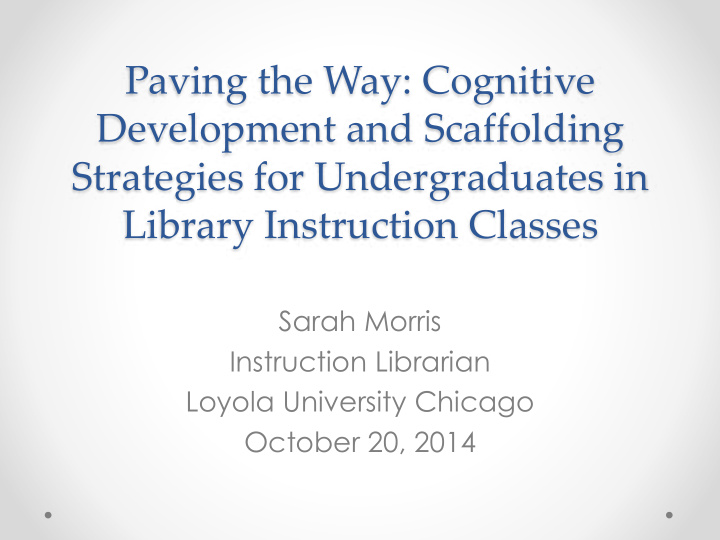



Paving the Way: Cognitive Development and Scaffolding Strategies for Undergraduates in Library Instruction Classes Sarah Morris Instruction Librarian Loyola University Chicago October 20, 2014
Transitioning from High School to College
Library Anxiety • Students can experience anxiety about using the library due to unfamiliar spaces, terms, procedures, etc. • Building up student confidence and student comfort-levels can help to combat anxiety
Today’s Focus • Exploring ideas and concepts to help librarians and other educators build up skills, knowledge, and confidence levels in their first-year student population
Information Literacy • Information literacy is a set of knowledge and skills that are closely related to critical thinking skills • Information literacy includes the skills and knowledge needed to find, access, and use information in a variety of situations
Cognitive Development • The idea that learners pass through different developmental stages of learning and understanding
Cognitive Development and First-Year Students • William Perry looks at cognitive development trends in college students • First- Years often at a “dualism” position Tend to view the world as good or bad; lack of nuance o Right answers exist for every question o Trust in authority for answers o Find information that reinforces pre-existing views o Will ignore uncertainty o • Jackson notes that many information literacy concepts and skills are beyond this dualistic position Example: Evaluating sources involves questioning authority and viewing o information as complex and nuanced, which might be beyond what a dualistic learner can accomplish on their own
Threshold Concepts • Concept areas where students can get “stuck” and have trouble progressing in their learning • Select traits of a threshold concept o Transformative — cause the learner to experience a shift in perspective; o Integrative — bring together separate concepts (often identified as learning objectives or competencies) into a unified whole; o Troublesome — usually difficult or counterintuitive ideas that can cause students to hit a roadblock in their learning
Learning About First-Year Students • Gathering student data • Building relationships with groups, departments, and individuals who work with first-year students to share ideas and information • Talk with students to get a sense of how they approach assignments, what they think about their assignments • More formal classroom assessment methods, including rubrics, tests, etc.
Why does this matter? • An understanding of cognitive development theories and related concepts can help provide concepts and a language for creating cross- campus partnerships • Cognitive development concepts can help educators create learning opportunities for students
Instructional Strategy: Scaffolding • An instructional process and design strategy that focuses on providing support and guidance to students as they learn and master new skills and ideas. • Some key traits of scaffolding: o Break down complex tasks o Start at an appropriate developmental level o Help to avoid information overload o Build up confidence by starting somewhere familiar and gradually building up autonomy and new skills
Instructional Strategy: Integrated Course Design • A variation of backwards design, where you begin with a learning outcome and work back from there to design class activities • Integrated Course Design places an emphasis on contextual factors that can impact learning, such as student population demographics, previous coursework, classroom setting, etc. Image from http://sites.temple.edu/edviceexchange/inte grated-course-design
Instructional Strategy: Learning Styles • Learning styles refer to how someone processes information • Learning styles can encompass a learners preferences, strengths, weaknesses, etc. • Key to create a learning environment that appeals to multiple learning styles by providing diverse instructional experiences
Working with First-Year Students at the Loyola University Libraries
Questions?
Recommend
More recommend